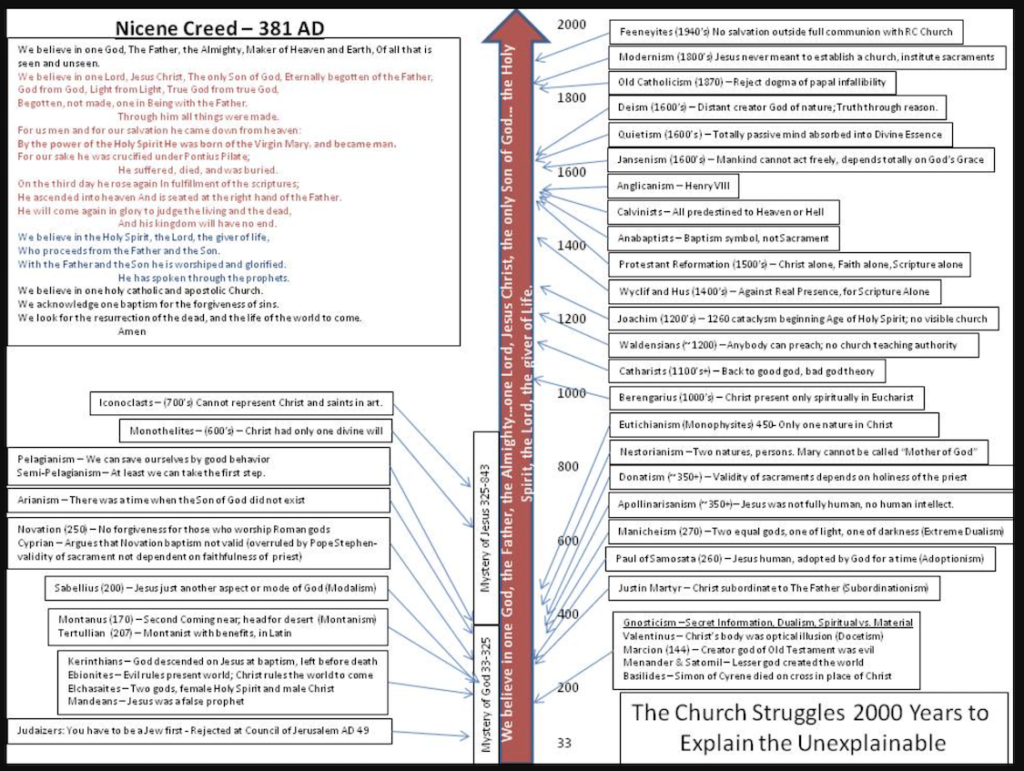An interesting way to view the history of The Church is through consideration of the struggle that has gone on through the centuries to understand and explain the unexplainable. From a Catholic viewpoint, possible explanations that were rejected by the church carry the label, “heresy,” meaning that while we have no full and complete and correct explanations of God, those particular rejected explanations have been judged to be wrong. I guess it is often easier to be clear about what does not work than about what does. Here is a list with an approximate timeline of many of the heresies than have been identified. Click on it for a readable version. The Nicene Creed, which addressed and rejected the major heresies of the time, originated at the Council of Nicaea in 325 and was amended at the First Council of Constantinople in 381.

If the above is difficult to read, try downloading the PDF version below. Feel free to use these but be sure to correct any errors before doing so!
First was the idea that one had to become a Jew (and be circumcised) before becoming a Christian. That was rejected at the Council of Jerusalem about 15 years after the resurrection. Then there were all those questions about Jesus. Was he divine or human or both? Was he prophet or savior? Was he created by the Father, adopted by the Father, just one form of the Father, subordinate to the Father, or equal to and co-existent with the Father? Did he have one nature or two, one will or two? Did He come to save the whole world, or all people or just some people or just certain people? Will he return physically or spiritually, now or later or never? Did He just come to model the way he wants us to live, or did he establish a Church and leave people in charge of it. Did he really die on the cross, or did somebody else take his place?
There were questions about God. Is he involved continually with his creation or did he just set everything in motion at the creation and sit back to see what happens? Was his creation evil or good or both? How could he have created evil, and if he didn’t, what is the explanation for evil in the world? Are there an evil god who created the earth and a good God, represented by Jesus, who rules the world to come?
What about the Church. Is it just an invisible conglomeration of believers, or is it supposed to take up space and have a voice in the world. Is it a democracy subject to the social pressures and whims of its members, or is there a teaching authority established by Jesus and handed down through the centuries to serve as a guide for society? Does the Church do such things as baptism and communion just in obedience to and in memory of Jesus Christ, or is God truly present and primary in such actions? Does the validity of such “sacraments,” if they are considered to be so, depend on the moral standing of the priest or pastor or only on the Grace of God?
And what about us and our salvation? Are we free and independent agents, choosing between good and evil, or are we totally dependent on God’s grace for anything good to happen. Or maybe we just need a little nudge from the Almighty to get us headed in the right direction. Or maybe our destinies have already been determined and we are just pawns. Are we to read the Bible and interpret it as we see fit, or is there help or even some final word from the Church to assist or perhaps inform our understanding?
If you look through the subjects on the above chart, you will find references to all these questions. And so far, the best statement we have of what we believe seems to be the Nicene Creed, finalized about 350 years after Christ and surviving now for more than 1600 years.
Thanks be to God for the gift of The Church, The Body of Christ.
My primary sources for the information in the exhibit were Dissent from the Creed by Richard M. Hogan, The Story of Christianity by Justo L. Gonzalez, and www.newadvent.org.